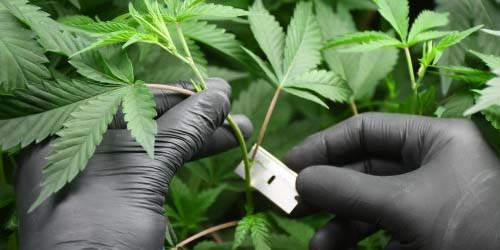
Highly experienced weed growers work with clones or cuttings. This is easier than continually germinating seeds and the quality of the harvest should improve. Sounds good, doesn’t it? If you’re planning to use clones, then you’ve come to the right place. In this article you can ready why taking cuttings is so popular, how you can take them yourself and what the pitfalls are.
In this article:
- Weed Cuttings - What are They?
- Taking Weed Cuttings - Step-by-Step Plan
- Taking Cuttings from the Parent Plant
- New Life
- Root Formation - Rooting Powder and Clone Gel
- Advantages of Weed Cuttings
- Disadvantages of Weed Cuttings - The Pitfalls
Weed Clones - What are They?
Cannabis clones are actually nothing more than dopplelgangers of another weed plant. A clone of the parent plant that is created by cutting off a piece from it and bringing it back to life. Once planted in new soil, a clone will find new life and produce its own roots. If you manage to get the clone to grow to full size, you will have a weed plant with exactly the same genotype as the parent plant. The same characteristics, the same yield, - everything the same in fact. Consequently, if you choose a good plant from which to take your clone, you are assured of a successful harvest. Furthermore, you will omit a couple of the laborious steps which you have to go through with new weed seeds.
It may sound simple, but there’s more involved in weed cuttings than you might think. To get proper clones, you have to know exactly what you’re doing. Don’t panic. We will teach you all about it!
With clones you are virtually guaranteed a high yield!
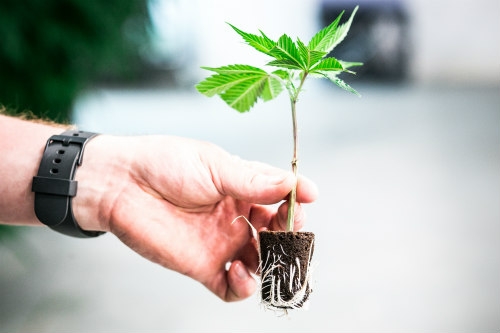
A perfect weed cutting with lots of roots
Cloning Cannabis - Step-by-Step Plan
If you want to clone your plants, it’s very important to select a good parent plant. As you’ve already seen, the genotype of the cuttings is actually identical to the parent plant. For that reason, choose your best-performing plant and get started with that. Follow the steps below:
1: Taking Cuttings from the Parent Plant
Cloning weed sounds really simple. But you have to look out for a lot of things. Firstly: hygiene. Is there too much dirt or too many bacteria present? If so, your cutting is doomed to failure. Make sure you have the following things before getting started:
- Gloves
- Secateurs, razor blade or other sharp object (clean)
- Scissors
- Clean jug of clean water
Look for a healthy, young branch which has sufficient nodes. The length is not that important. Count the nodes from top to bottom. The point at which you will cut the branch will ideally be between the third and fourth nodes. Try not to cut directly under a node, but just about 2 or 3 centimetres underneath. Now that you have chosen the position, take clean secateurs or a razor blade. NB: don’t cut straight but make an angled end to the branch This is important because in this way the plant gets more room for root formation.
You now have the basis of your cutting in your hands. For convenience we call this the stock. Now cut off all side branches (as closely as possible along the stock). You only retain the stock with the upper leaves. Take hold of the leaves tightly and cut off half of them. You do this because the cutting has no possibility of taking up water for the first few days. The reduced-size leaves inhibit loss of moisture from the plant as far as is possible. Place the cuttings in a clean jug of fresh water (lukewarm) to protect them against drying out. View the clip at the bottom of the page to get a clear idea about how to take the cutting from the parent plant (action from 02.40 to 04.00).
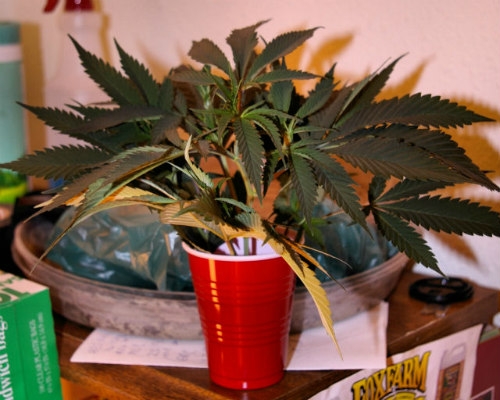
Freshly cut clone in a jug of water
2: New Life
Requirements:
- Soil (or another medium)
- Plagron pH-min
- Something for pricking a hole in the soil
- Rooting Powder or Clone Gel (optional)
Now that you have cloned parent plant in the correct manner, it’s time to bring the clone back to life. You want the clone to produce roots, so that it will eventually achieve full size. Just like its parent. You do this by placing it back in the soil or another medium. It’s important to make the soil nice and damp, but not soaking wet. This keeps enough oxygen present. In addition, the pH value of your medium is very important. You can adjust this with pH-min from Plagron. Ideally, the value should be around 6.3. Taking weed cuttings is a painstaking procedure and the clones themselves are very vulnerable so try to create optimum conditions for them.
When you have prepared the soil, prick a hole in it with a toothpick (or another object as long as it’s clean). Then remove a cutting from the water and place it in the soil. Make sure the cutting is deep enough in the soil and firmly placed.
An important aid for cannabis clones to take successfully is rooting powder or clone gel, but it is not essential. If you use rooting powder or gel, apply it to the bottom of the cutting, up to the wound of the first node from the cutting point. Stick the cutting into the soil up to the part where the gel or powder is located. Your chances of success are less without this stuff. Read more about rooting powder further on in this article.
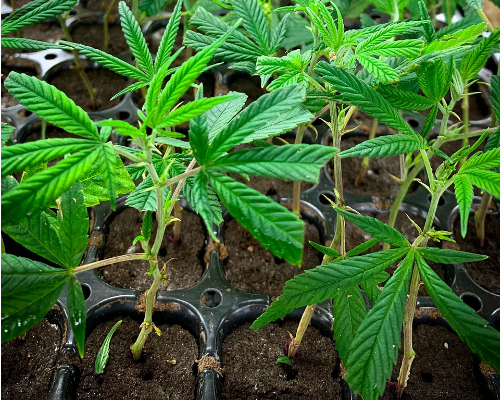
Weed cuttings in new soil
3: Root formation
Requirements:
- Propagator
- Plant spray
- Lamp (not a powerful type such as LED or HPS)
With the cannabis clones in new soil there is still something to do. You need to give them a helping hand by placing them in an ideal climate. In other words: one with high humidity and lots of light. Only then can they produce enough roots. You need tools for this, such as a propagator. This is a small cabinet with heating and lighting with which you can create the proper climate. It’s fair to say that you will save yourself a lot of trouble by buying a propagator. Making one yourself is pretty difficult and root formation is an important part of taking weed cuttings. Accuracy is important.
The most important thing is to make sure that the clones don’t dry out as they haven’t got any roots. You’ve already taken measures by trimming the leaves but that isn’t enough. Once you have the cuttings in a propagator, it’s important to spray them every now and then with a plant spray. Furthermore, the youngsters need plenty of light. But please note: they are not mature enough to withstand powerful HPS or LED lamps. Use an energy-saving lamp or another well-used lamp at home and make sure they get about 16 to 18 hours of light per day. The other 6 to 8 hours will then feel like night during which they can produce their roots.
The roots ought to be visible after 7 to 10 days. Given that cuttings are delicate, it’s sensible to wait longer than 7 days before looking.
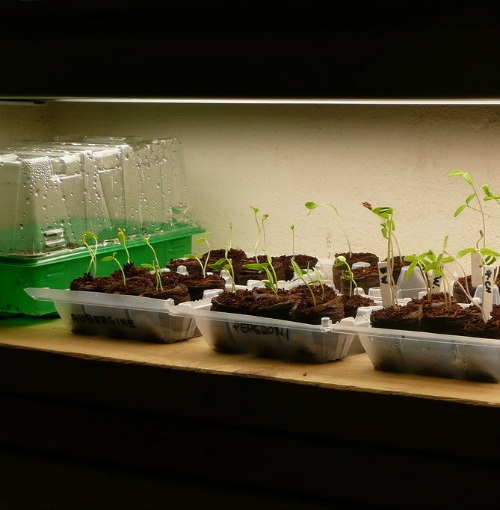
A humid, lit propagator on the left. A number of cuttings which are ready for root development on the right.
Rooting Powder and Clone Gel
Rooting powder or clone gel is commonly used when taking cannabis clones. Cuttings go wrong more often without this aid. Rooting powder or gel contains hormones to promote faster root growth. Furthermore, it forms a protective layer against diseases which is very beneficial given that weed cuttings are highly susceptible. Rooting powders or clone gels are often completely natural and don’t contain any pesticides or other nasty substances. They contain precisely enough elements to provide small clones with roots. For that reason don’t use any other forms of plant food such as root stimulator. This would be counter-productive to root growth. Do you want to be sure that the weed cuttings will succeed? Buy rooting powder or clone gel!
Advantages of Cloning Cannabis
You might be thinking: why go to all that trouble? Are weed cuttings worth the effort? Some growers swear that all the trouble is definitely worth it. They base that on the following advantages:
- No more need to germinate: germinating weed seeds is a process that doesn’t always work. Weed seeds are natural products and therefore there is always something that can go wrong. It costs a lot of time, effort and attention to create a tiny plant from a weed seed. With cannabis clones you bypass all this.
- Best genotype: as you read earlier in this article, the big advantage of a cannabis clone is that you always get the same characteristics as the parent. In this way, you are eliminating the uncertainty.
- Yield: because you know that your weed plant has good characteristics, you are virtually guaranteed a high yield. That is not the case with newly germinated seeds. With them, you just never know.
- Costs: making cannabis clones is almost completely without cost. The biggest cost item is the purchase of the propagator. But once you’ve invested in it, you’ll be able to use it for a long time.
Disadvantages of Cloning Cannabis - The Pitfalls
Naturally, there is always the reverse side of the coin. We want to inform you about the disadvantages which lie in wait as well:
- As you’ve been reading, there’s more to cloning cannabis than you might think at first. It’s not easy to take cuttings. Be aware that you’ll need to devote much time and attention for otherwise it’s doomed to failure.
- Buying cannabis clones from someone else is always risky. You don’t know anything about the parent plant and so you could be disappointed. Therefore always make sure you know what plant the cuttings were taken from, or take them yourself.
- It all sounds fantastic: ‘The same characteristics as the parent plant’. But that necessitates having a good parent plant in the first place. Cultivating a top-quality weed plant is more difficult than you think. Let an experienced grower help you or be patient and wait until you’ve successfully cultivated a masterpiece.
- The appearance of the weed plant can be different from that of the parent plant. That has to do with more factors than just the parent’s genetics. Light, moisture, pH, feed and the temperature all influence the growth and flowering of your cutting.
Continue Growing
Made beautiful clones? Then it is time to continue breeding. Are you going to do that inside? Then you have to choose between LED and HPS. Or maybe you can use both? Read all about it in our blog: "LED Grow Lamp For Cannabis - Pros and Cons".